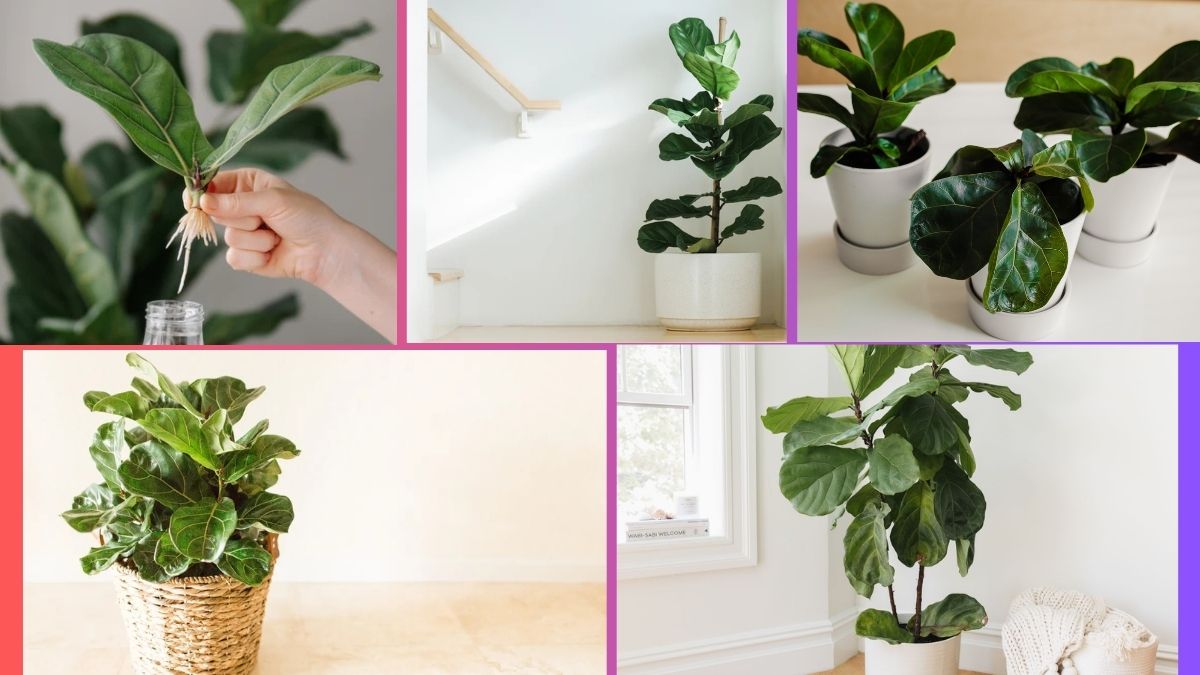The Fiddle Leaf Fig (Ficus lyrata) has quickly become one of the most sought-after and iconic houseplants in modern home décor. Known for its bold, violin-shaped leaves and dramatic height, this tropical beauty adds instant style and elegance to any indoor space. However, while the Fiddle Leaf Fig is stunning, it’s also famously finicky — especially when it comes to watering.
A question that every fiddle leaf fig owner inevitably asks is:
How often should you water a Fiddle Leaf Fig?
The answer isn’t as straightforward as a set number of days. Watering frequency depends on several factors, including the plant’s size, the season, your home’s environment, and the type of soil it’s planted in. In this comprehensive guide, we’ll uncover the optimal watering schedule for a fiddle leaf fig, how to recognize signs of overwatering or underwatering, proper watering techniques, and expert care tips to keep your plant lush, green, and thriving.
Introduction to Fiddle Leaf Figs
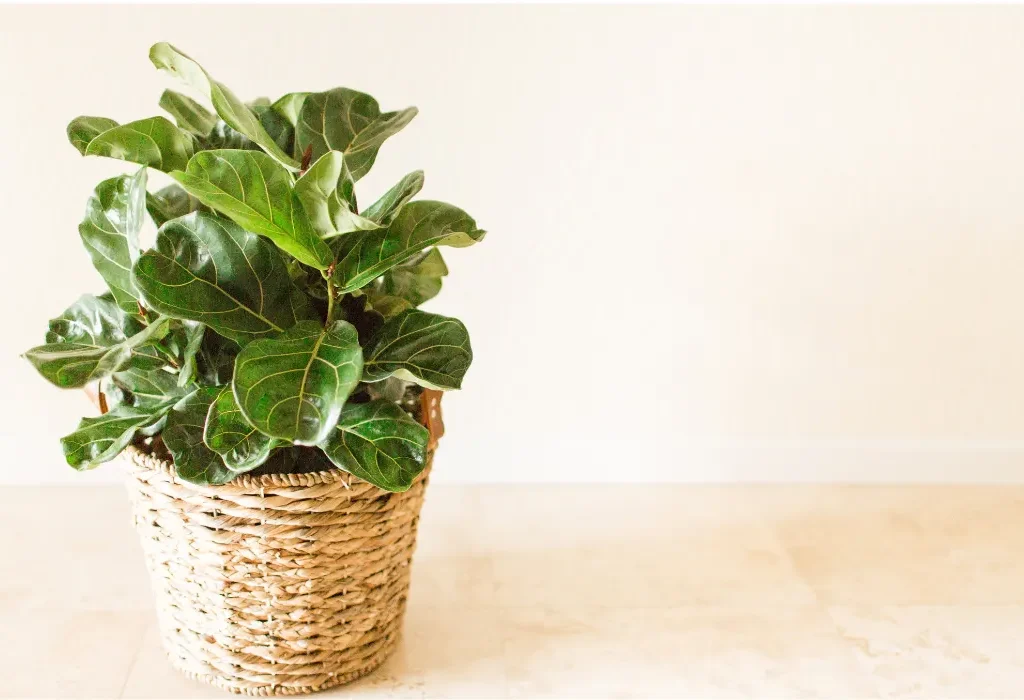
Native to the tropical rainforests of West Africa, the Fiddle Leaf Fig is a type of fig tree that can grow over 40 feet tall in the wild. Indoors, it’s typically kept between 3 to 10 feet tall, depending on care and pruning.
Its large, glossy, dark green leaves are sensitive to environmental changes, making consistent care — especially in terms of watering — essential for maintaining its beauty and health.
How Often Should You Water a Fiddle Leaf Fig?
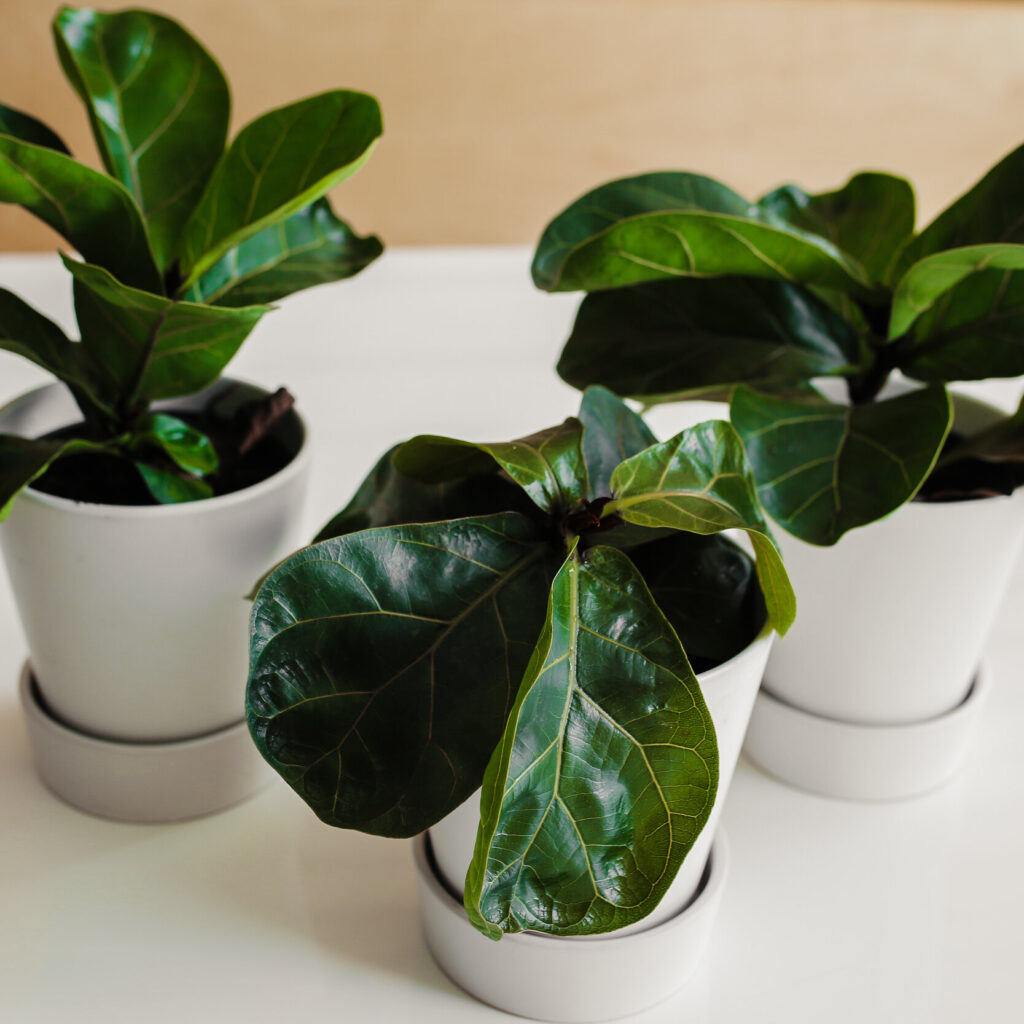
On average, you should water a fiddle leaf fig once every 7–10 days during its growing season (spring and summer) and once every 10–14 days during its dormant season (fall and winter).
However, watering needs vary based on factors like light exposure, pot size, soil type, humidity, and temperature. The most reliable method is to check the top 1–2 inches of soil and water only when it feels dry to the touch.
General Watering Rule:
- Spring & Summer (active growth): Every 7–10 days
- Fall & Winter (dormant season): Every 10–14 days
Important: Always prioritize the soil’s moisture over a strict calendar schedule.
Factors That Affect Fiddle Leaf Fig Watering Frequency
Understanding what influences your fiddle leaf fig’s water needs is key to avoiding common mistakes:
Season and Temperature
- Warm months (spring and summer): Higher temperatures and active leaf growth increase water requirements.
- Cooler months (fall and winter): Lower temperatures and slower growth reduce water needs.
Indoor Climate and Humidity
Fiddle Leaf Figs thrive in moderate to high humidity (50–65%). Dry indoor air from heating or air conditioning can cause the soil to dry out faster, requiring more frequent watering.
Pot Size and Material
- Smaller pots dry out faster than larger containers.
- Clay or terracotta pots are porous and absorb moisture, causing soil to dry quicker than plastic or glazed ceramic pots.
Light Exposure
Fiddle Leaf Figs need bright, indirect light to stay healthy. The more light it receives, the faster the soil will dry out, increasing watering frequency.
Soil Type
A well-draining, airy soil mix is crucial. Dense, compacted soils retain water too long, increasing the risk of root rot.
Signs Your Fiddle Leaf Fig Needs Watering
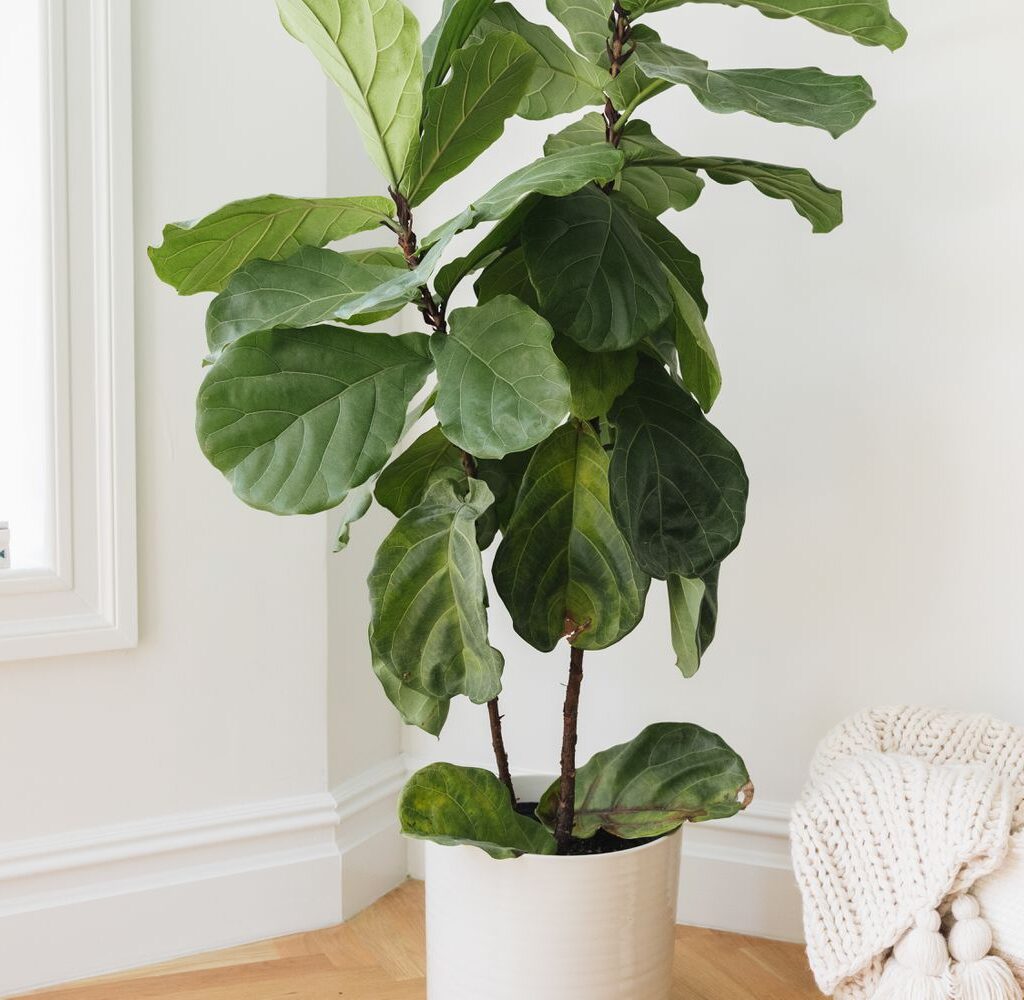
Your plant will show clear signs when it’s thirsty. Be attentive to these indicators:
Dry Topsoil
Use your finger to check the top 1–2 inches of soil. If it feels dry, it’s time to water.
Drooping or Limp Leaves
Leaves may droop or appear wilted when the plant lacks moisture.
Crispy, Brown Edges
Leaf edges may turn brown and dry out from prolonged underwatering or low humidity.
Slow or Stunted Growth
In its growing season, insufficient water can cause your fiddle leaf fig’s growth to stall.
Signs of Overwatering a Fiddle Leaf Fig
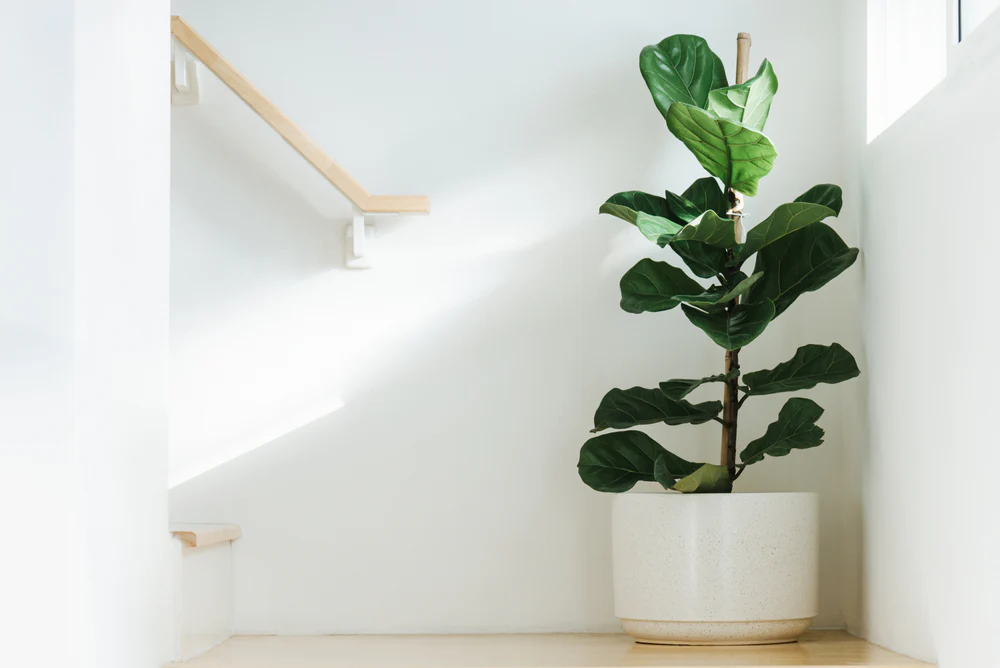
Overwatering is one of the most common problems and can lead to serious plant health issues. Watch for these warning signs:
Yellowing Leaves
Lower leaves turning yellow is often the first sign of excess moisture.
Drooping Leaves Despite Moist Soil
If leaves are wilting while the soil remains wet, root rot may be developing.
Moldy or Mushy Soil
Fungal growth or a sour odor from the soil surface indicates consistently soggy soil.
Black or Brown Leaf Spots
These spots, especially near the leaf base, can be a symptom of bacterial infection or rot caused by overwatering.
How to Properly Water a Fiddle Leaf Fig
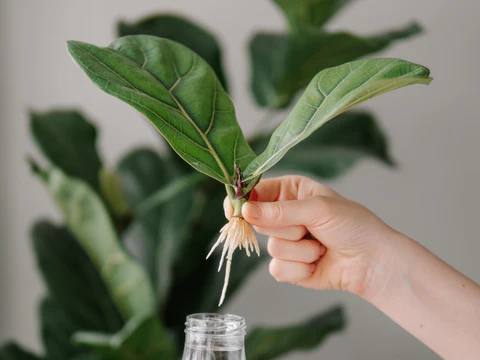
The right watering technique ensures your fiddle leaf fig stays vibrant and healthy. Follow these steps:
Use the Soak and Dry Method
- Water the plant thoroughly until water drains freely from the pot’s drainage holes.
- Discard any excess water in the saucer beneath the pot.
- Allow the top 1–2 inches of soil to dry out before watering again.
Tip: Avoid letting your plant sit in standing water.
Use Room-Temperature Water
Cold water can shock the roots. Always use lukewarm or room-temperature water for watering.
Check Soil Moisture Before Every Watering
Use your finger or a moisture meter to test the soil’s moisture level before adding more water.
Seasonal Watering Adjustments for Fiddle Leaf Figs
Here’s a helpful seasonal watering guide to adjust your routine:
| Season | Watering Frequency | Notes |
|---|---|---|
| Spring/Summer | Every 7–10 days | Active growth and higher temperatures increase moisture needs. |
| Fall/Winter | Every 10–14 days | Slower growth and lower temperatures reduce water use. |
Always check soil moisture before watering, regardless of the season.
Best Type of Water for Fiddle Leaf Figs
Fiddle Leaf Figs are sensitive to chemicals in tap water, especially chlorine and fluoride, which can lead to leaf burn and tip browning.
Ideal Water Choices:
- Filtered water
- Distilled water
- Rainwater
- Tap water left to sit out for 24 hours to allow chemicals to dissipate
Additional Fiddle Leaf Fig Care Tips
In addition to proper watering, consider these tips to help your fiddle leaf fig flourish:
- Light: Bright, indirect light is ideal. Direct sunlight can scorch leaves, while low light can stunt growth.
- Humidity: Maintain 50–65% humidity; use a humidifier or mist leaves occasionally in dry environments.
- Soil: Use a well-draining mix containing peat moss, perlite, and bark.
- Fertilizing: Feed with a balanced liquid fertilizer every 4–6 weeks during spring and summer.
- Pruning: Remove yellowing or damaged leaves and prune to shape the plant as needed.
- Repotting: Repot every 1–2 years or when roots become cramped.
Why It’s Better to Underwater Than Overwater
Fiddle Leaf Figs are moderately drought-tolerant and can recover from occasional underwatering better than overwatering. Excess water suffocates roots, promoting rot, while slight dryness encourages deeper root growth.
When in doubt, wait an extra day and check soil moisture before watering.
Conclusion
How often should you water a Fiddle Leaf Fig?
The rule of thumb is to water once every 7–10 days in spring and summer and every 10–14 days in fall and winter. However, it’s crucial to monitor soil moisture and environmental conditions, adjusting your routine as needed.
By using the soak-and-dry method, ensuring proper drainage, and observing your plant’s signs, you’ll be well on your way to growing a healthy, thriving fiddle leaf fig that will become the statement piece of your home.
